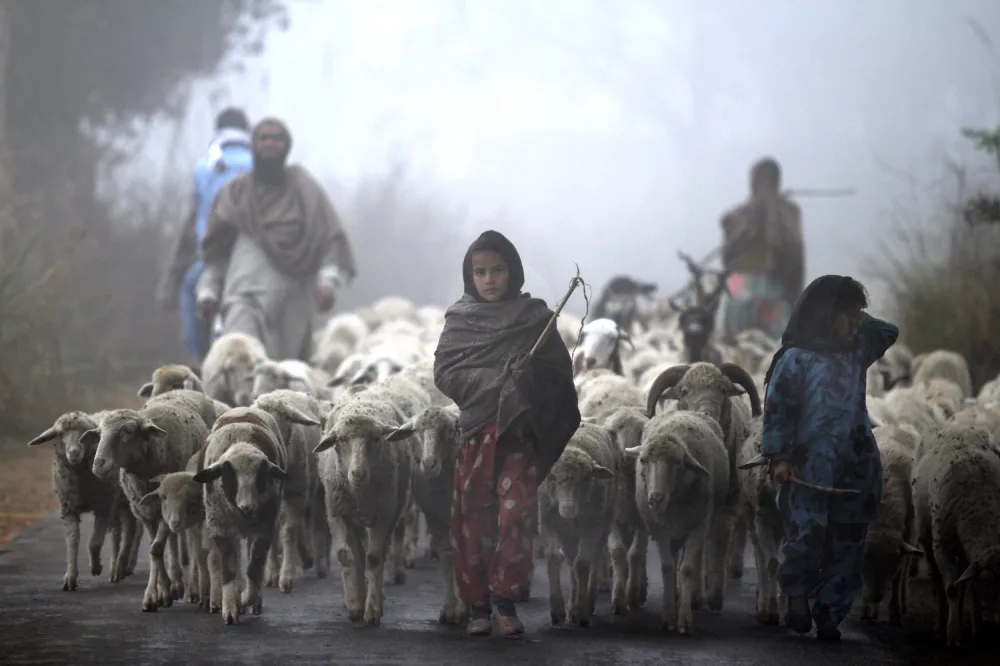Copyright Foreign Policy

PEER KI GALI, Jammu and Kashmir—It was a breezy, sunny noon at Peer Ki Gali, a mountain pass in the Pir Panjal range of the Himalayas, connecting the Poonch and Shopian districts of Jammu and Kashmir. As the sun and clouds played hide and seek, 20-year-old Asima Chaudhary, a Gujjar-Bakarwal herder, a nomadic community known for rearing sheep and goats across the mountains, watched her flock grazing on the slope. Her dhoka, a stone-and-mud shelter, was a 20-minute walk away through steep, uneven terrain. Of the 1.49 million, Gujjar-Bakarwals in Jammu and Kashmir, many still undertake seasonal migrations between Jammu’s plains and Kashmir’s high-altitude meadows. Women, who manage households and herds during these grueling journeys, contribute almost nothing to carbon emissions yet bear the brunt of climate change: erratic heat waves, unpredictable snowfall, and resource scarcity. Their struggles extend beyond physical hardship into a silent mental health crisis largely absent from policy discussions. For women like Asima, these abstract statistics and policy gaps translate into grueling daily routines across steep slopes, where every step carries both physical strain and mental burden. As Asima’s elder brother returned from his lunch break, he whistled in her direction. Recognizing the signal, Asima picked up her sweater and stick and began walking toward her dhoka. “He’ll take care of the herd now. I’ll go have tea and fetch some water while mother cooks,” she said, continuing along the narrow trail. Midway, she paused and gestured toward a patch of grass. “Not that way, it’s wet and slippery,” she cautioned. Her quick instinct and sharp eye for the terrain revealed how well she knew every inch of the hillside, knowledge built through years of living and herding in these mountains. This deep familiarity with the mountains makes the changes Asima has witnessed over recent years all the more striking. Sitting outside her dhoka, she spoke about how the growing heat has worsened her family’s daily struggle for water. “Five years ago, we could fill our pots from the spring just behind our dhoka,” she said, adjusting her scarf against the sun. “Now we walk for hours, and the path is dangerously steep. Some days, we go twice, morning and evening, just to have enough for cooking and drinking.” The water shortage becomes especially challenging during menstruation. “There are no washrooms, and bathing is already hard. We used to make small enclosures near the spring, but now even that basic dignity is a struggle,” Asima said. “Sometimes it feels suffocating,” she said of the daily challenges for survival. “We keep asking ourselves, why do we have to live like this?” Asima’s struggle is emblematic of a broader reality faced by Indigenous women whose daily lives and well-being are intimately tied to the land. For these women, the physical hardships of migration intersect directly with mental health challenges, with anxiety, depression, and chronic stress creating what experts describe as a silent, widespread crisis largely absent from policy discussions. “Indigenous women’s lives are inseparably tied to the land and forests. Unfortunately, climate change strikes at the very root of their existence, acting as a force of cultural and economic disruption. It directly affects women’s mental health through multiple interconnected pathways,” Bijayalaxmi Rautaray, a development practitioner who works on health and livelihood issues with Indigenous women, told Foreign Policy. “In these communities, women bear the burden of the entire family. Erratic weather, droughts, and landslides force herders to walk farther and work harder to sustain their households. Even collecting firewood has become a physically exhausting task, adding to the strain they already carry,” Rautaray added. According to a 2021 Jammu and Kashmir Policy Institute study, climate change is reshaping life for Gujjar-Bakarwal communities, with women disproportionately affected. Drying springs, erratic rainfall, and longer treks for water force these women into cycles of exhaustion that have serious mental health consequences, from persistent anxiety to sleep deprivation. Experts say such lived experiences reveal a critical policy blind spot, one where mental health remains largely excluded from climate and health planning. “While there’s growing recognition that climate and health responses must include mental health, the lived experiences of Indigenous and nomadic communities still receive very little attention,” said Anant Bhan, a global health and bioethics researcher. “With worsening weather disruptions, groups living on the margins—like nomadic populations—face disproportionate risks. Their well-being, including mental health, must become a central part of climate and health planning.” He added, “Policy frameworks need both flexibility and depth to respond to these realities. Addressing such challenges requires a multi-sectoral approach, one that links health, climate adaptation, livelihoods, and income support, so that no community is left behind.” This policy invisibility compounds daily life for women like Asima, whose physical and mental strain is continuous, intensified by the lack of accessible health services and societal support. “Indigenous women live with stress, anxiety and at times face depression, but they don’t know how to explain it to doctors,” said Arif Maghribi, a psychiatrist who conducts mobile medical camps along the migration routes of Gujjar-Bakarwal communities. “Language barriers and social stigma often leave these ailments untreated,” he added. “Social pressures, including the practice of consanguineous marriages common in the community, add another layer of stress, particularly for women caring for children at higher risk of developmental challenges or intellectual disabilities.” These challenges reflect a broader pattern documented among Indigenous women worldwide. A 2023 Women Deliver report examining climate impacts on marginalized communities found that environmental change amplifies existing gender and health inequalities, especially in remote, resource-dependent populations. The research reveals a gap: When climate adaptation plans fail to integrate sexual, reproductive, and mental health services, they deepen the very vulnerabilities they aim to address. For Gujjar-Bakarwal women, this policy gap means tangible daily consequences—drying springs, erratic rainfall, and longer treks for water that force them to traverse treacherous terrain multiple times daily, a physically exhausting routine that makes basic needs like menstrual hygiene and bathing increasingly difficult to maintain. The loss of grazing lands compounds household economic stress, a burden that falls disproportionately on women who must find ways to stretch dwindling resources. “The mountains are changing, and so is our life,” Asima said, her voice carrying the weight of exhaustion. “What our mothers and grandmothers did easily, we now struggle with every day. It’s not just about walking further for water or finding less grass for our animals, it’s about feeling helpless and wondering if this life is even possible anymore. The struggle doesn’t just tire our bodies, it breaks something inside us.” Asima’s struggle is shared by many others in the mountains. Two miles away is another dhoka where 18-year-old Samina Chaudhary lives with her family of eight. Like Asima, she spends her days tending to the herd, but her responsibilities extend beyond the pastures. Samina’s burden intensified three years ago when her younger brother began showing signs of developmental delays, a condition Maghribi explained might be linked to consanguineous marriage common in their community. Now, in addition to herding and household work, she helps care for her brother while managing her own health struggles. “Some nights I cannot sleep, thinking about everything, the animals, my brother, whether we’ll have enough water tomorrow,” she said, twisting the edge of her dupatta. “My mother says I worry too much, but how can I not? The weight of it all sits on my chest.” “Being a woman here means carrying the weight of the family and the herd together,” Samina said. “We walk miles to fetch water, tend to the animals, cook, clean, and take care of everyone, including visiting relatives. On top of that, we manage our health and privacy in a place where nothing comes easy. Every day is hard, but we rely on each other to keep going and survive.” The friendship between Samina and Asima, formed over years of neighboring migrations, has become a lifeline for both. When isolation and stress become overwhelming, they seek each other out along the mountain trails; not just to share stories about herds and routines, but to discuss the intimate emotional and physical challenges they share that neither can fully explain to their families. For women who become mothers in these harsh conditions, the daily challenges grow even heavier. For 22-year-old Rubeena Ali, pregnancy was one of the toughest periods of her life. “There was no rest, no time to think about myself,” she recalled. “Even carrying water or cooking felt heavier, and I worried all the time about the baby when I climbed the steep slopes.” Since birth to a baby girl a month earlier, life had grown even more demanding. When the period of seasonal migration began, her family made the difficult decision to leave her behind with relatives. Rubeena had just delivered and could not walk long distances or carry her newborn safely. “It was such a difficult phase,” Rubeena said. “I was adapting to a new lifestyle and needed my immediate family, especially my husband, around me. But they had to keep going for survival, while I stayed behind for my health and the baby’s safety. Every day, I would think of my family and cry in isolation.” Even now, the responsibilities of caring for her newborn, combined with memories of that isolation and the ongoing stress of climate uncertainty, weigh heavily on her. “Every day feels like carrying a mountain on my shoulders,” Rubeena said. “The heat, the water, the animals, the baby–it all comes together, and I feel tension, musibat [misery], all the time. Sometimes I just want to disappear, but I can’t. I have to keep going for my family.” For women like Rubeena, these broader systemic and environmental pressures translate into very real daily struggles that are both physically exhausting and mentally taxing. Maghribi, the psychiatrist, noted that “pregnant women in these nomadic communities endure extreme stress from climate challenges. Yet no one talks about how this affects their mental health. Policies ignore them, and authorities often dismiss their struggles, thinking awareness might ‘spoil’ the community. It’s unethical; they face immense challenges they had no role in creating.” According to Bhan, women in nomadic communities like the Gujjar-Bakarwals are among the most vulnerable to climate-induced stress and disruption. “Given their migratory lifestyle, these women face multiple layers of risk, from displacement and disrupted livelihoods to increased caregiving burdens and lack of health care access,” he said. “Climate-related events such as floods and droughts can worsen these pressures, leading to heightened mental health challenges, delayed care-seeking, and deepened gender inequities. The social context, marked by heavy workloads, limited support, and domestic violence, only amplifies the psychological toll.” As Bhan’s insights highlight the larger policy gaps, local doctors like Maghribi are calling for practical, community-based solutions. “Just like mobile schools follow Gujjar-Bakarwal children, mobile medical vans should travel with the communities, providing care for chronic illnesses and mental health support where they live and migrate,” Maghribi said. For now, as the mountains grow harsher and springs vanish, women like Asima, Samina, and Rubeena continue to carry both the water and the weight of a changing world. Their lives reveal a silent crisis: Climate change is not just an environmental or economic threat; it is a profound mental health emergency for women whose survival depends on mobility and resilience.



